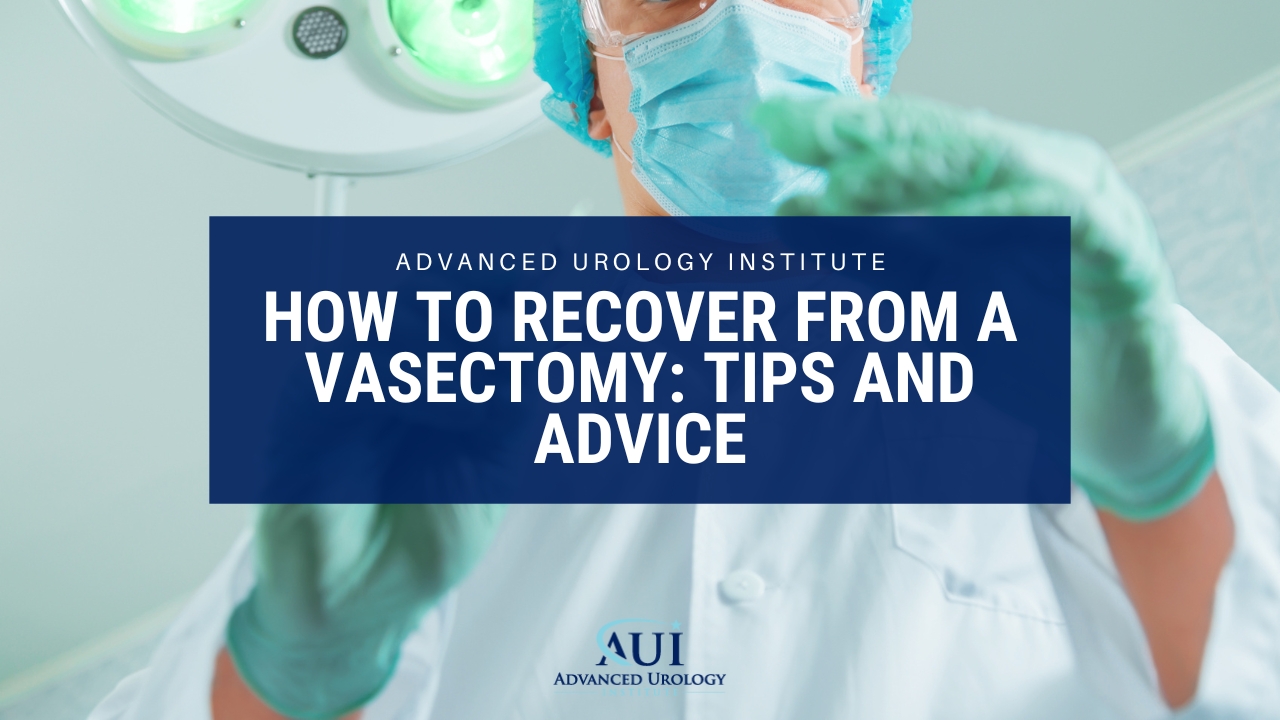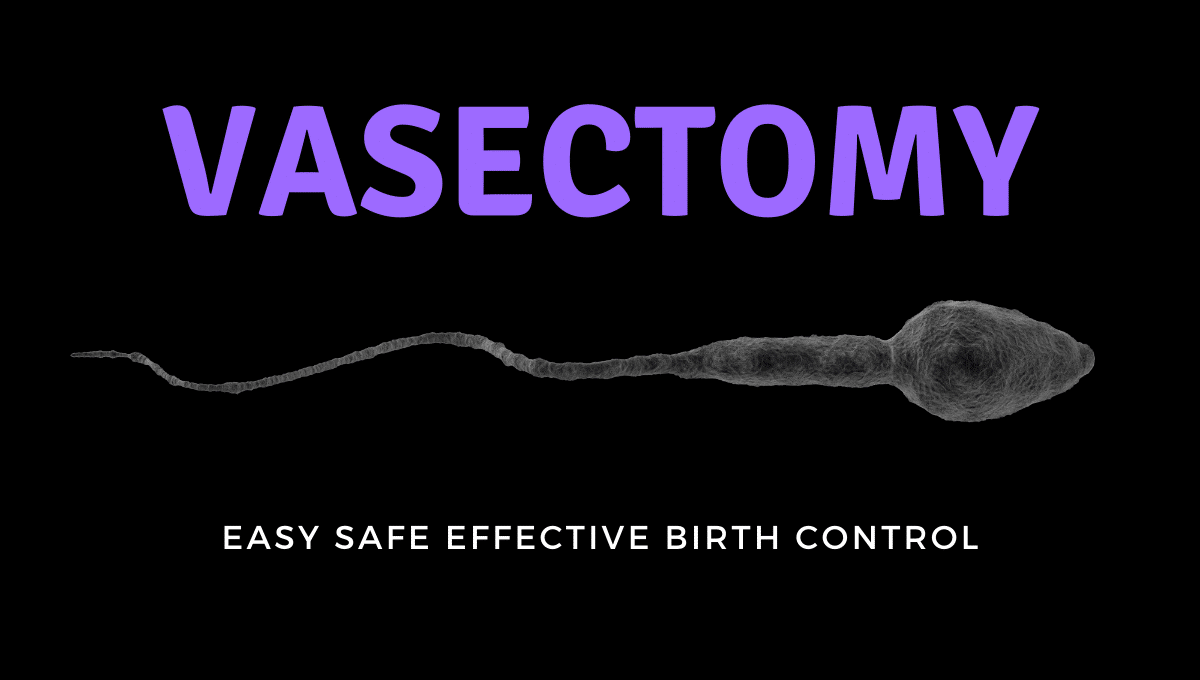Exploring vasectomy and the full implications is crucial when making the decision to have the surgery says Dr. Epstein of St Augustin, FL.
Continue readingWhat is National Men’s Health Month and why is it important for men’s health?
National Men’s Health Month (NMHM) is an annual observance in June to bring awareness to the overall health and well-being of men.
Continue readingVasectomy Alternatives: What Are Your Options?
Vasectomy is the most common form of male sterilization and is a popular choice for couples who have completed their families. However, there are other alternatives to vasectomy, choices people might not be aware of.
Continue readingHow to Recover from a Vasectomy: Tips and Advice
It is very important for those who have had a vasectomy to do the necessary steps for recovery in order to avoid any further complications. This includes consulting with a medical professional before the procedure, having a clear understanding of the risks, and following the doctor’s instructions.
Continue readingDebunking the Top 5 Vasectomy Myths
It is no surprise then that so many questions and myths about vasectomies exist. This article debunks five of the most common vasectomy myths with evidence from clinical studies. With accurate information and knowledge that vasectomies are a safe, effective and long-term option, men can make an informed decision.
Continue readingVasectomy and Age: Is There Right Time To Get the Procedure?
What is Vasectomy Recovery Like?
How effective is a vasectomy reversal?
My name is Yaser Bassel. I’m a board certified urologist with Advanced Urology Institute.
When we counsel patients before they get a vasectomy, we do tell them that this is considered a permanent form of sterilization. However vasectomies can be reversed. The vasectomy reversal process is typically one that is not covered by insurance so it can be expensive but it is possible and typically with seventy-five to eighty percent (75-80%) success rates. [While], I do not personally perform the vasectomy reversals themselves, I do have a partner that specializes in that area. So if that is something men are interested in, that is something that is offered by our practice.
Vasectomy: Easy Safe Effective Birth Control
As a permanent method of birth control, vasectomy has been around for decades with good results. Today it is performed as a routine procedure with over 500,000 operations done in the United States each year.
During the procedure, the vas deferens (the duct that carries sperm from the testicles to the urethra) is cut or blocked to prevent sperm from being released during ejaculation. Sperm must travel from a man’s testicles to the urethra for pregnancy to occur during sexual intercourse, and blocking this passage is what makes vasectomy an effective method of birth control.
How is a vasectomy performed?
 A vasectomy is an outpatient procedure that must be performed in a medical facility or in a doctor’s office. In one technique, the urologist makes two small incisions on either side of the scrotum in order to gain access to the vas deferens. In another technique, the urologist makes one small incision to access both tubes. After accessing the tubes, the doctor cuts and seals them and then adds stitches if necessary. Doctors perform vasectomy under local anesthesia, making it as painless as possible. The procedure takes 10-20 minutes and the patient is free to go home immediately.
A vasectomy is an outpatient procedure that must be performed in a medical facility or in a doctor’s office. In one technique, the urologist makes two small incisions on either side of the scrotum in order to gain access to the vas deferens. In another technique, the urologist makes one small incision to access both tubes. After accessing the tubes, the doctor cuts and seals them and then adds stitches if necessary. Doctors perform vasectomy under local anesthesia, making it as painless as possible. The procedure takes 10-20 minutes and the patient is free to go home immediately.
Recovery from the operation is easy. Your doctor will give you clear instructions which, if followed, will allow you to get back to normal in a few days. To ensure a quick recovery, you will need to apply cold packs to the area for 12-48 hours and lie on your back as much as possible. Wearing comfortable underwear or a jockstrap will protect the area. It is common to have mild discomfort, bruising and swelling of the scrotum for a few days after a vasectomy. In case of persistent and considerable pain, contact your doctor for advice. Unless your job is strenuous, you can return to work in 1-2 days. However, you must avoid heavy lifting for at least a week to avoid aggravating the wound.
How effective is vasectomy?
Vasectomy boasts of a better success rate than even the most effective forms of female contraception. The chance that a vasectomy fails (and a man impregnates his partner after the operation) is anywhere from 0.3% to 9% in the first six months after surgery. This is usually because it will take a few months for semen to be fully without sperm. Doctors suggest using another method of birth control such as condoms until follow-up analysis of semen shows zero sperm. But after this initial period, the failure risk of vasectomy drops to between 0.04% and 0.08% (about 1 in 2000). In comparison, the failure rate of intra-uterine device (IUD) is 0.2% to 0.8% while that of tubal ligation is nearly 1% during the first year after the procedure. Therefore, vasectomy is not only the best birth control method for men, but also one of the best overall.
Easy, safe and effective birth control
Vasectomy is a safe and low-risk way a man can take on the medical responsibilities of family planning. Whether you want to commit to a child-free life or do not want any more children, vasectomy is a long-term, discreet, 10-20 minute procedure with no danger to your hormonal balance and sex life. It is safer than common forms of contraception for women and recovery is quick and easy. Although this procedure should always be considered a permanent change, the success rate for vasectomy reversals is between 40% to 90% depending on how the original procedure was performed. If you decide that you do not want any more children, this procedure is worth discussing with your doctor. For more information, visit the Advanced Urology Institute website.
Vasectomy: A Quick and Easy Birth Control
A vasectomy can be done in two ways:
1. No scalpel Vasectomy. In this procedure, a urologist feels the scrotum and finds the vas deferens. Once the vas deferens can be felt, a clamp is placed on it to hold it in place. A hole is made in the skin and the vas deferens is lifted out. It is cut and the separate ends are tied and put back into place.
2. Conventional Vasectomy. Small incisions are made on each side of the scrotum. The vas deferens is then cut and a small piece of it may be taken out. The separate ends are then tied or seared. This procedure often requires the use of an anesthetic.
The procedure takes about thirty minutes. The outcome, however, takes a while to be realized. Most professionals advise that it takes about three months, or at least 15-20 ejaculations, for semen to become completely sperm free. Before then, it may be advisable to use other forms of birth control. Aftercare usually requires mild pain medication and wearing supportive underwear. Ice packs also can help with the pain. Most men recover within one week.
What to consider before undergoing a Vasectomy
The high success rate of a vasectomy requires absolute certainty on the part of the man that he does not wish to have any more children. In instances in which the man is married, it is necessary for him to discuss the matter with his spouse. A vasectomy is widely considered to be irreversible. When it is reversible, the procedure is sensitive and difficult.
The importance of having the advice of a urologist before, during and after the procedure cannot be understated. Qualified urologists can be found in most hospitals and the search for one can be undertaken online. The Advanced Urology Institute runs a site with very relevant information and this can be a good place to start. For more information on vasectomy, visit the “Advanced Urology Institute” site.
What is a Vasectomy?
Quick and highly-effective
A vasectomy is a quick, 15-to-30-minute procedure and you can return home the same day. Designed to be a permanent form of contraception, a vasectomy is extremely effective in preventing pregnancy — nearly 100 percent. It is one of the most effective methods of birth control you can find. Vasectomy — also called male sterilization — is meant to protect against pregnancy permanently, so it’s super effective once you are past the first three months following surgery when the semen has become sperm-free.
After the procedure, pregnancy is prevented round-the-clock for the rest of your life. Once the doctor confirms that you no longer have sperm in your semen, then you don’t to do anything else to prevent pregnancy.Of course there is a very slim chance of the cut ends of the tubes growing back together after the procedure, making it possible to cause a pregnancy. That, however, very rarely happens.
Types of vasectomy
The vasectomy procedure involves cutting and blocking or partially removing both ends of the vas deferens (the sperm duct). Once that is done, sperm traveling from the testes can no longer reach the semen and form part of the ejaculate. Two types of vasectomies exist: the no-scalpel method and the incision method. The no-scalpel (no-cut) technique has a lower risk of infection and complications and generally requires a shorter recovery time. Because it’s classified as a minor surgical procedure, a vasectomy is often done in the doctor’s office with the patient under local anesthesia. It’s only in a small percentage of men where the procedure is performed in the operating room with general anesthesia or sedation — either due to the results of a doctor’s physical exam or patient preference.
Doesn’t hurt as much as often perceived
Vasectomy is a safer, minimally-invasive birth control method and a more effective procedure compared to tubal ligation. Guys generally tolerate it better than women do with tubal ligation. While you will experience a sharp sensation when the numbing medication is applied with a small needle, there should be no further pain after that. If you experience any further discomfort, inform your doctor so more of the numbing medication may be given or action is taken to alleviate the discomfort. Most men find vasectomy less painful than they anticipated, although a mild swelling and soreness may be experienced after the procedure.
Recovery after a vasectomy
Some mild swelling and discomfort is to be expected for a few days after the procedure, but almost always is gone completely by the end of the first week. It’s recommended that you take 1-2 days off work to reduce your activity level and get ample time to recover — although men with physically strenuous jobs may require a longer break from work. For the first 48 hours after the procedure, keep your activities limited and apply cold packs to your scrotum 3-4 times a day, with each application lasting for about 20 minutes. Wear supportive underwear until the discomfort subsides or for at least a week. Avoid sexual activity and exercise until the discomfort disappears, usually after around one week. Don’t soak in a pool, open water or hot tub for at least 3 weeks to ensure your wound heals quickly — you may just shower and dab dry. Return to normal activity slowly, building up your activity level gradually.
At Advanced Urology Institute, we do vasectomies in the office, using the no-scalpel, no-needle procedure. However, if you’re squeamish about it then you can have the procedure in a surgical room — although for most guys, doing it in the office is alright. The procedure takes about 20 minutes and is not bad in terms of pain. Recovery is also very fast. Most men schedule it on Friday and are back to work on Monday. As long as you don’t engage in strenuous activities such as a heavy lifting kind of a job, you can resume work quickly.
So if you want freedom from the fear of having unwanted children and want to enjoy your sexual relations without worrying about a pregnancy, a vasectomy is the ideal contraception for you. For more information on vasectomy, visit the “Advanced Urology Institute” site.
Vasectomy: Easy, Safe, and Effective Birth Control
Vasectomy is a common form of birth control. More than 50 million men have undergone the procedure worldwide. In the United States, around 500,000 men get a vasectomy each year. Vasectomy is an easy, safe and effective surgical procedure carried out in a clinic, doctor’s office or hospital. The outpatient procedure takes 10-20 minutes and the patient can go back home on the same day. While it is still the fourth most preferred method of contraception after oral pills, condoms and tubal ligation, it is one of the cheapest, safest and most effective family planning options.
Vasectomy Procedure
During a vasectomy, the small tubes of the scrotum that transport sperm are blocked or cut off to prevent sperm from leaving the body and causing pregnancy. The name vasectomy comes from the vas deferens, the scrotal tubes that are blocked or cut off during the procedure. Vasectomy is intended for permanent sterilization, so while it can be reversed, only those who are sure they no longer want more children should undergo the procedure.
There are two common vasectomy techniques: the no-cut (no-scalpel) method and the incision method. No-scalpel technique is a lower-risk procedure that minimizes the chance of infection and complications while also taking less time to heal. Nevertheless, whatever method is used, vasectomy is a quick procedure performed with local anesthesia or IV sedation, depending on the patient’s condition and surgeon’s preferences. After numbing, one or two small incisions are used to access the vas deferens so they can be clamped, sealed or cut to disrupt sperm flow. The procedure is performed on both sides.
Recovery from vasectomy
Recovery time after vasectomy varies, but most men are able to return to normal physical activity in 2-3 days. Recovery is quite easy as the patient is able to go home soon after the procedure, rest, apply ice packs for 24-48 hours, watch football over the weekend and be able to resume work the following week. However, it is important to notify your doctor of any severe bruising, swelling, fever, pus or chills. These may indicate internal bleeding or infection and should be dealt with appropriately.
Safety and efficacy
Vasectomy is a highly effective method of preventing pregnancy, guaranteeing almost 100 percent efficacy. It is a safe and low-risk procedure, with just about 1 percent of men reporting side effects such as infection, bleeding and pain. Compared to tubal ligation, vasectomy is faster, less painful and has fewer potential complications. Vasectomy does not significantly change the amount of semen as only sperm will be absent from the ejaculate. It also does not change the way a man ejaculates or feels when having orgasm, so your sex life will remain the same except there will be no worry about pregnancy.
At Advanced Urology Institute, we use the most up-to-date no-scalpel techniques to perform vasectomy and vasectomy reversal quickly, painlessly and effectively. We take great care to review the medical history of every patient, evaluate and counsel our patients, answer all patient questions and ensure that only the right candidates undergo the procedure. We also deliver a safe and effective procedure through a patient-centered, multidisciplinary approach that guarantees the best services for all our patients. At AUI, your health is our number one priority. For more information on vasectomy and vasectomy reversal, visit the “Advanced Urology Institute” site.
Thanksgiving is The Best Time To Get A Vasectomy
Considered the easiest and safest form of surgical sterilization, vasectomy is an outpatient procedure in which the tubes (vas deferens) that carry sperm from a man’s testicles to the urinary tract are cut to stop the release of sperm during sexual intercourse. During a vasectomy, a small cut made through the skin on the front surface of the scrotum is used to bring the vas deferens to the skin level, allowing the vas to be cut or cauterized (burned) before being tied or clipped off and then dropped back into the scrotum.
After a vasectomy, a man is encouraged to rest for a few days. During the first 24 hours after the procedure, it is recommended that he apply an ice pack on the scrotum or use a package of frozen peas to reduce discomfort. The ice pack should be wrapped in a towel and should not be placed directly on the skin. Recovery takes a few days and the man can resume routine work within 3 days, but should avoid exercise and heavy lifting for at least one week.
Choosing to undergo a vasectomy is a big step in your life, and like most big life decisions, the timing of the procedure is critical. In fact, while the procedure is typically an outpatient routine, the recovery period requires ample rest, which makes it important to carefully choose the time to have the procedure. Even for a really tough guy who would like to go back to work soon after a vasectomy like it is no big deal, recovery still means a few days of soreness and discomfort which need to be properly timed to minimize inconvenience as much as possible.
So when is the best time to have a vasectomy?
1) March Madness
For sports fans, March offers lots of good entertaining TV watching, particularly during the first weekend of the NCAA Basketball Tournament. It is also a perfect time to schedule the procedure because it allows you to rest on your couch and enjoy the games on TV while your body recovers from the operation. In fact, many urologists across the United States have reported that there is a massive increase in the number of vasectomies scheduled in the period leading to the NCAA tournament (as many as 50 percent more procedures during this season than at any other time of the year). So if you are thinking about having a vasectomy, the Thursday and Friday of the first weekend of the NCAA tournament is a good time to undergo the procedure and then kick back for the entire weekend with your ice pack and great games involving your favorite players and teams.
2) A Four-day Weekend
Due to the down time involved in recovering from a vasectomy, a four-day weekend is ideal for the procedure. In this case, you can take a Friday off from work if there is a holiday the following Monday, such as Labor Day or Memorial Day. The time is adequate for you to relax and enjoy quiet activities as you recover from the operation. Scheduling the procedure on a Thursday or Friday also will reduce the amount of time you will miss from work.
3) Thanksgiving Weekend
After a vasectomy, it is recommended that you get enough rest and avoid activities that may require exertion. There is no better time of the year that you can find complete rest from exertion than during the Thanksgiving weekend. Thanksgiving weekend provides four days for you to enjoy delicious food, watch football, spend time with family members and engage in other activities that you desire. So you can schedule your operation just before the big day’s feast in order to have enough time to recover. Of course, you should avoid traveling over that weekend and stay away from the traditional annual touch football family game.
Have you decided to undergo a vasectomy or have questions about planning for a vasectomy? Advanced Urology Institute is the place for you to find the best information and get the safest and most effective vasectomy. As a leader in vasectomy in Florida, Advanced Urology Institute offers top-notch vasectomy techniques such as the no-needle no-scalpel procedure that is less invasive and causes minimal discomfort, fewer complications and requires a shorter recovery time. For more information on how to find the best urologist for treatment of urological problems and for the vasectomy procedure, visit the “Advanced Urology Institute” site.
Where is the best place to get a vasectomy reversal in Florida?
All men who undergo a vasectomy are counseled to consider the procedure a permanent form of male sterilization. However, a number of factors such as loss of child or remarriage may call for vasectomy reversal. If you are a man who had a vasectomy in the past but are now considering a reversal, it is important to remember that the procedure is complex and requires specialized expertise and experience to perform successfully.
Where is the best place to get a vasectomy reversal in Florida?
While there are many qualified vasectomy reversal doctors and facilities in Florida, one of the best places to undergo the procedure is Advanced Urology Institute. This multi-dimensional urology practice has locations throughout Florida, including well-equipped clinics in Panama City, Daytona Beach, Blountstown, Perry, St Augustine, Daytona Beach, Port Orange, Tallahassee, Carrabelle, Orange City, Palm Coast, Oxford and other towns, bringing highly qualified and board certified urologists closer to those in need of their medical care. Advanced Urology Institute surgeons perform hundreds of vasectomy reversals every year with a remarkable success rate. The urologists are highly trained in their surgical technique and perform all procedures in accredited clinics with board-certified anesthesiologists who ensure maximum comfort during surgery.
Initial Consultation
A vasectomy reversal at Advanced Urology Institute means access to exceptional treatment and care at a center with an international reputation that offers vasectomy reversal as a specialization. You can schedule surgery over the phone, have your pre-operative appointment with a urologist the first day, and undergo the operation the next day. During the initial consultation, the urologist will review your history, personally perform a complete examination, and request any necessary tests such as blood studies, semen analysis and ultrasound exam. The urologist will discuss all options currently available, and the relative success rate of each, and will help you make the right choice.
Affordable Cost
The total cost for a vasectomy reversal at Advanced Urology Institute is less than $7,000. These charges include hospital, surgical and anesthesia fees, but exclude post-op semen analysis. You may have a secondary blockage in the epididymis (where sperm is stored behind the testicle) in which case the urologist will examine the fluid coming out of the proximal vas for sperm to rule out a blockage. When there is no blockage, the urologist will proceed with vasovasostomy, a simple vasectomy reversal procedure in which the vas deferens is sewn back together. In case of a blockage, there will be no sperm and the vas deferens will have to be connected directly to the epididymis at the point above the obstruction. This is done through vasoepididymostomy, a more complex vasectomy reversal procedure in which the doctor attaches the vas deferens straight to the back end of the testicles. There will be no additional charges for the complex reversal as the urologist will decide on the appropriate type of reversal at the time of surgery.
Book Your Appointment
Vasectomy reversal at Advanced Urology Institute is an outpatient procedure that is completed in one day. Follow-up appointments may be scheduled the day after the operation and you will return to routine work after 3-4 days. Sexual activity may be resumed after 2 weeks. If you have been considering a vasectomy reversal, be sure to call Advanced Urology Institute and request an appointment for more information.
What is Vasectomy? with Dr. Warren Hitt
Video: What is Vasectomy? with Dr. Warren Hitt
Vasectomy prevents the sperm from joining the semen before the semen is ejaculated. This is done by cutting the vasa deferentia, in which the sperm travels from the testicles to its resting location in the seminal vesicles. Contact a urologist now to learn more about this procedure. [Read Full Article…]









 Vasectomy is a permanent form of birth control that prevents a man from fathering biological children. The question of when to undergo the procedure is a personal one and there is no right time or age. However, on average, men tend to get the procedure at 35 years or older. It is important to note that a
Vasectomy is a permanent form of birth control that prevents a man from fathering biological children. The question of when to undergo the procedure is a personal one and there is no right time or age. However, on average, men tend to get the procedure at 35 years or older. It is important to note that a 




